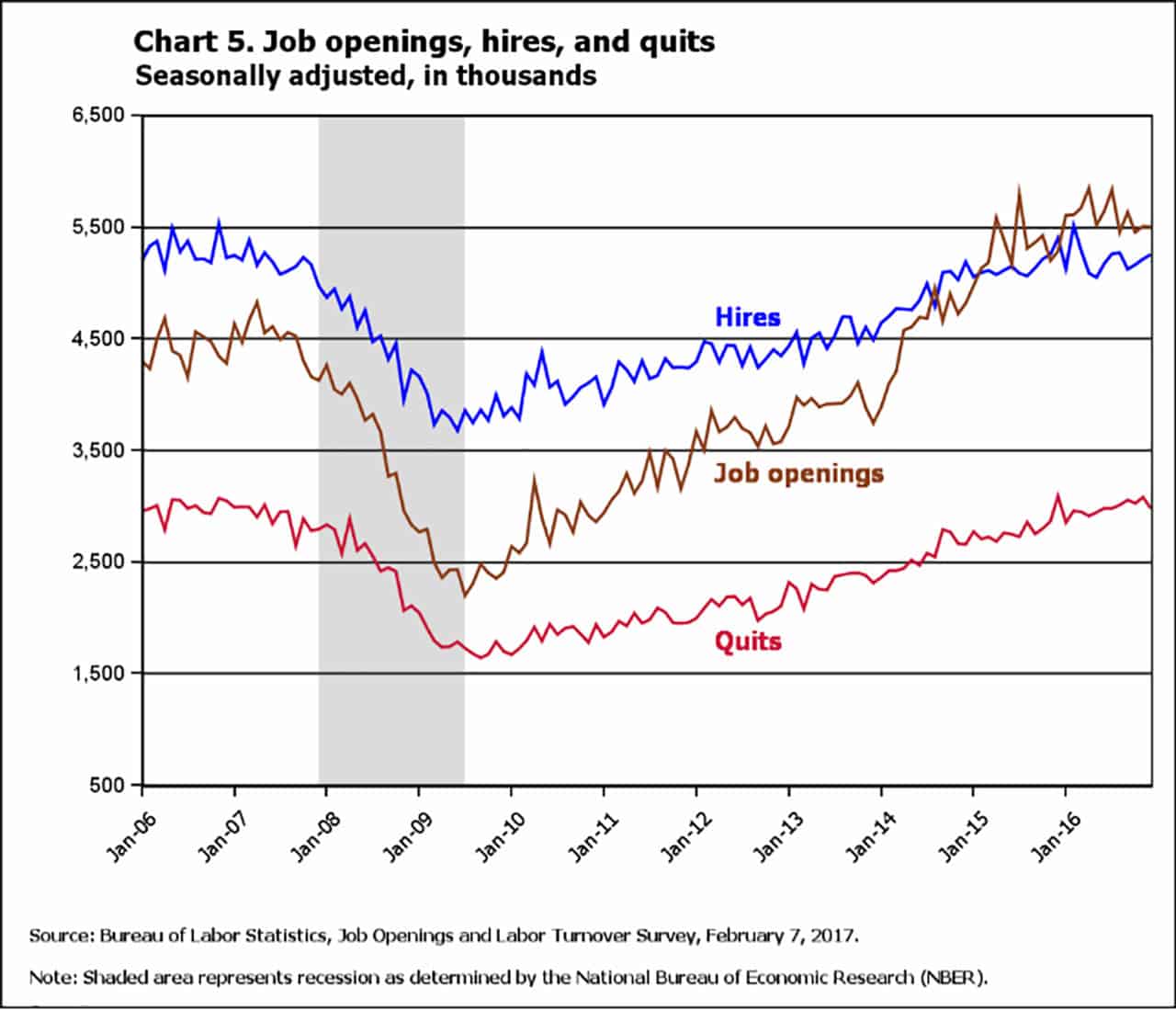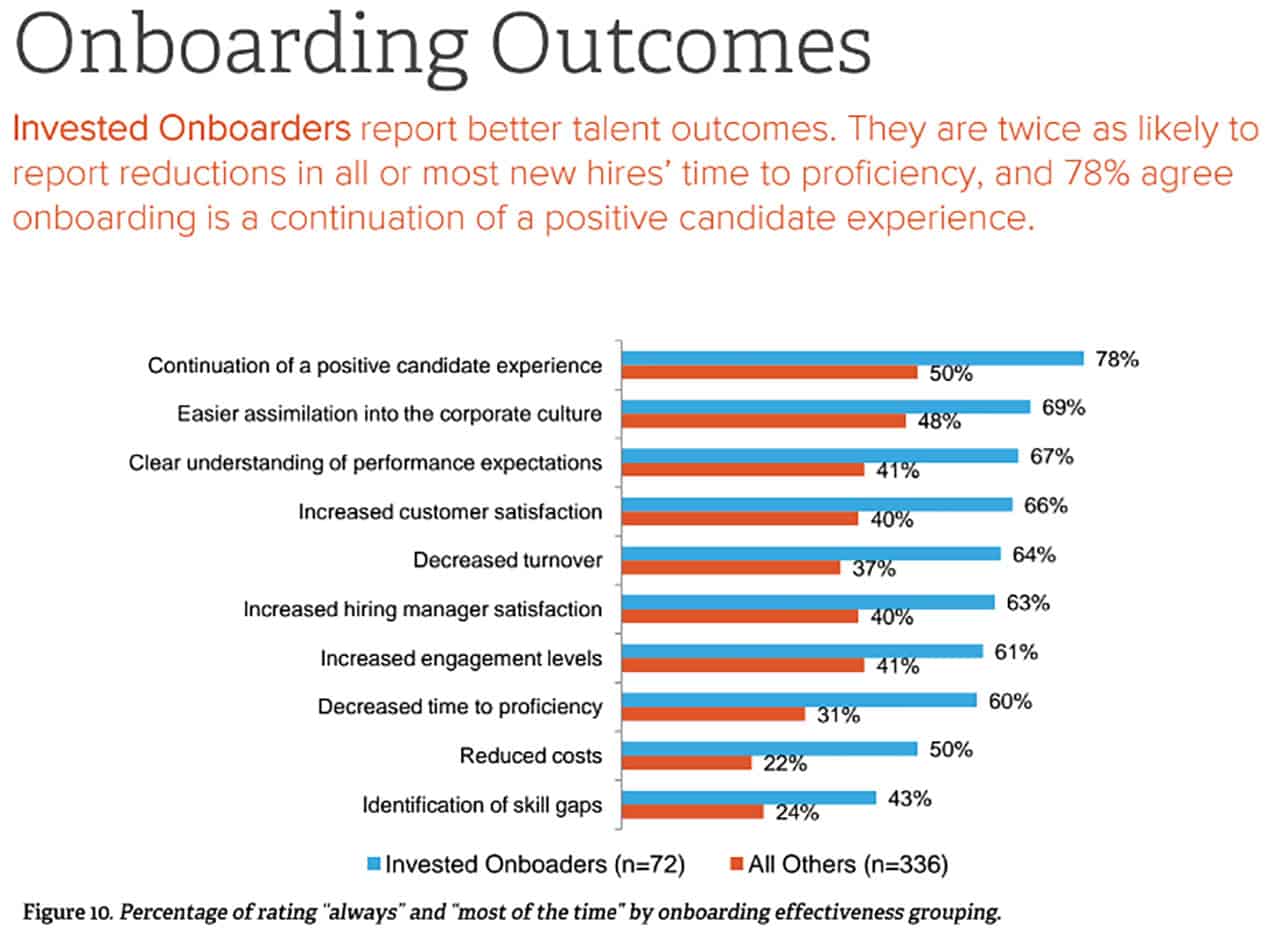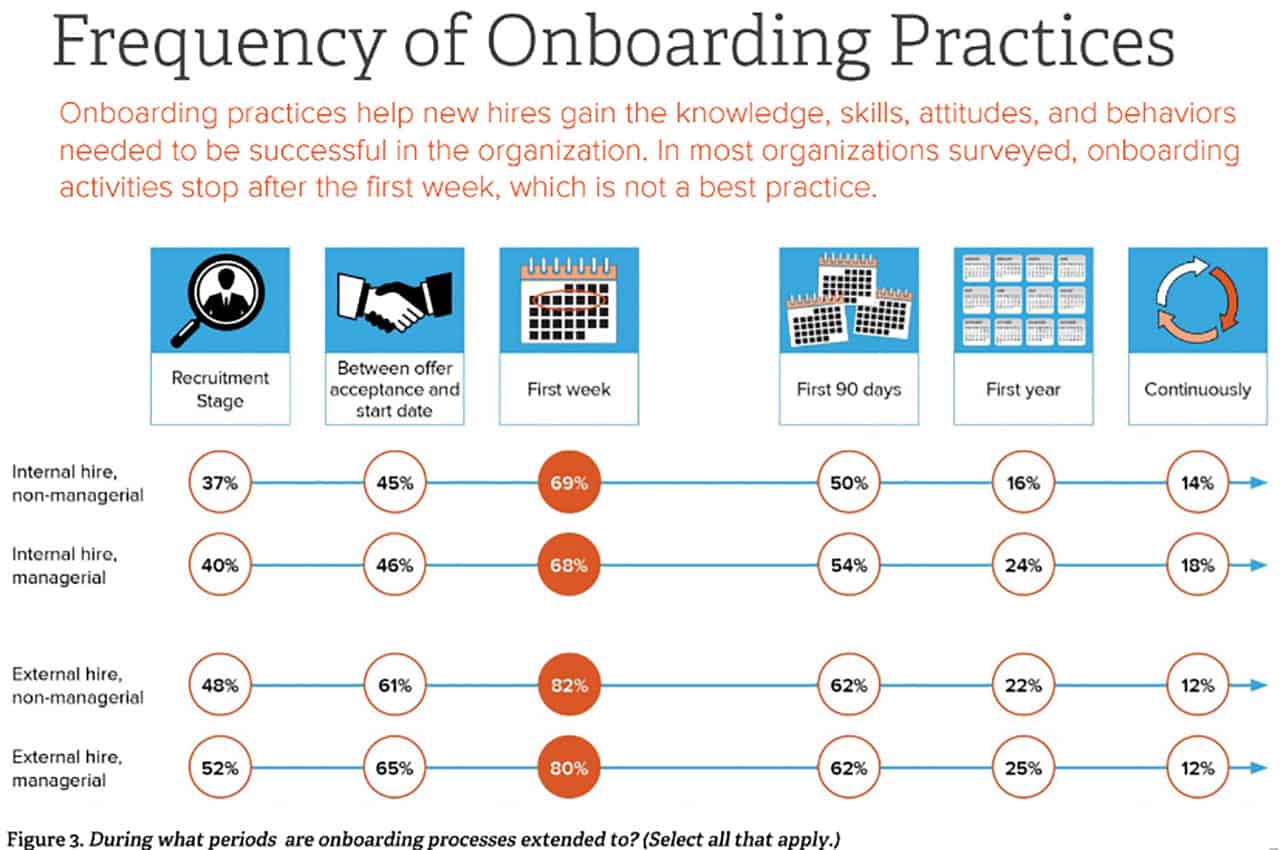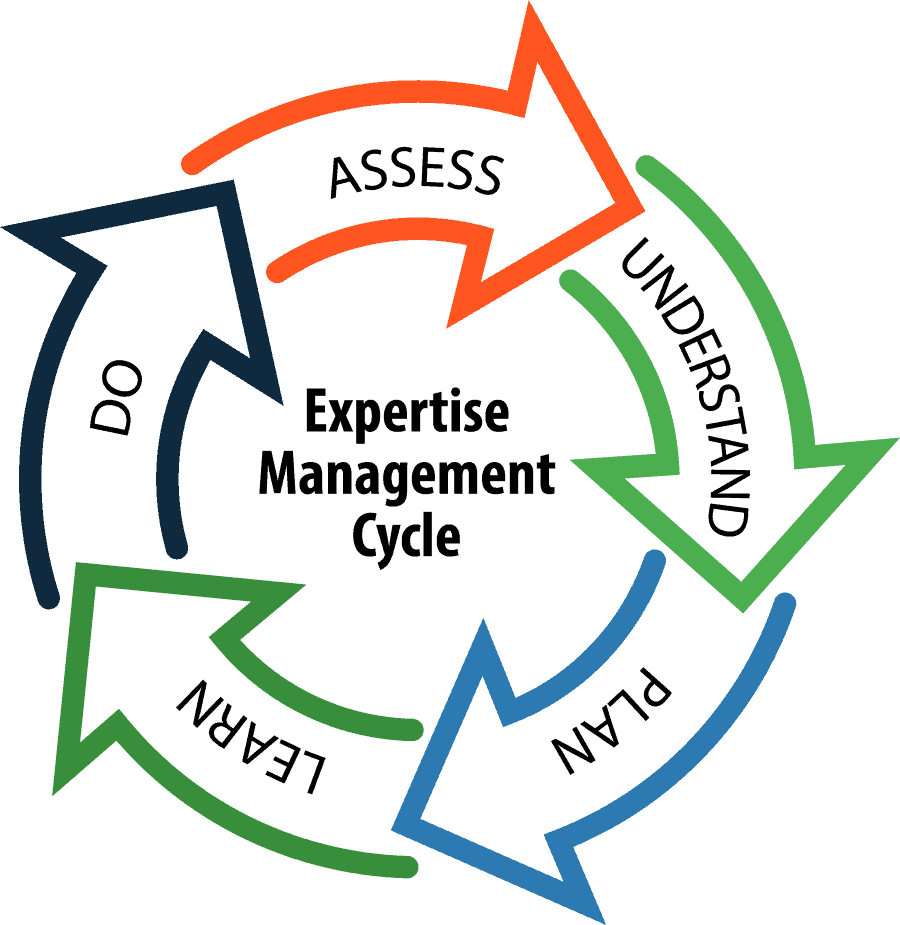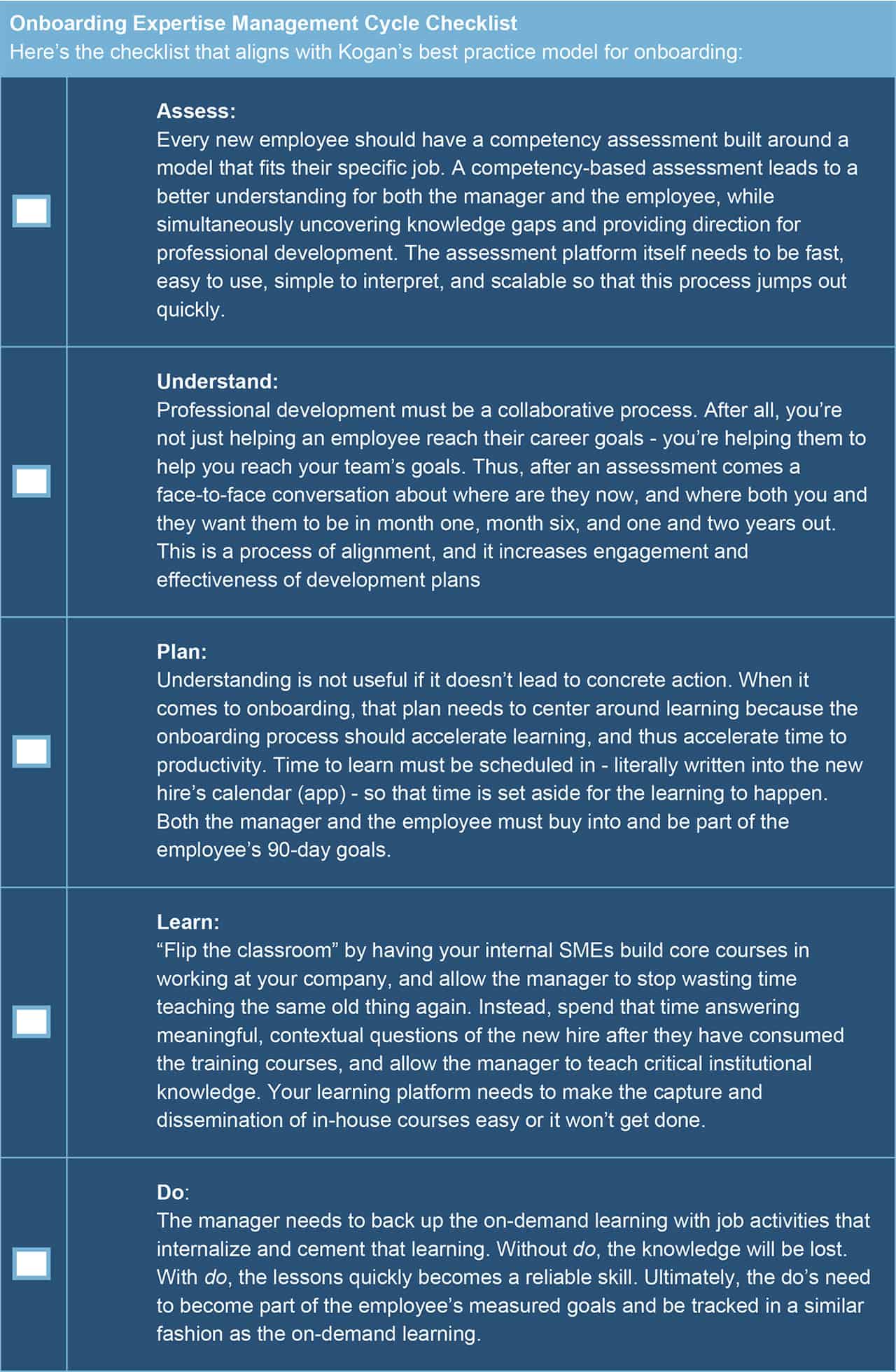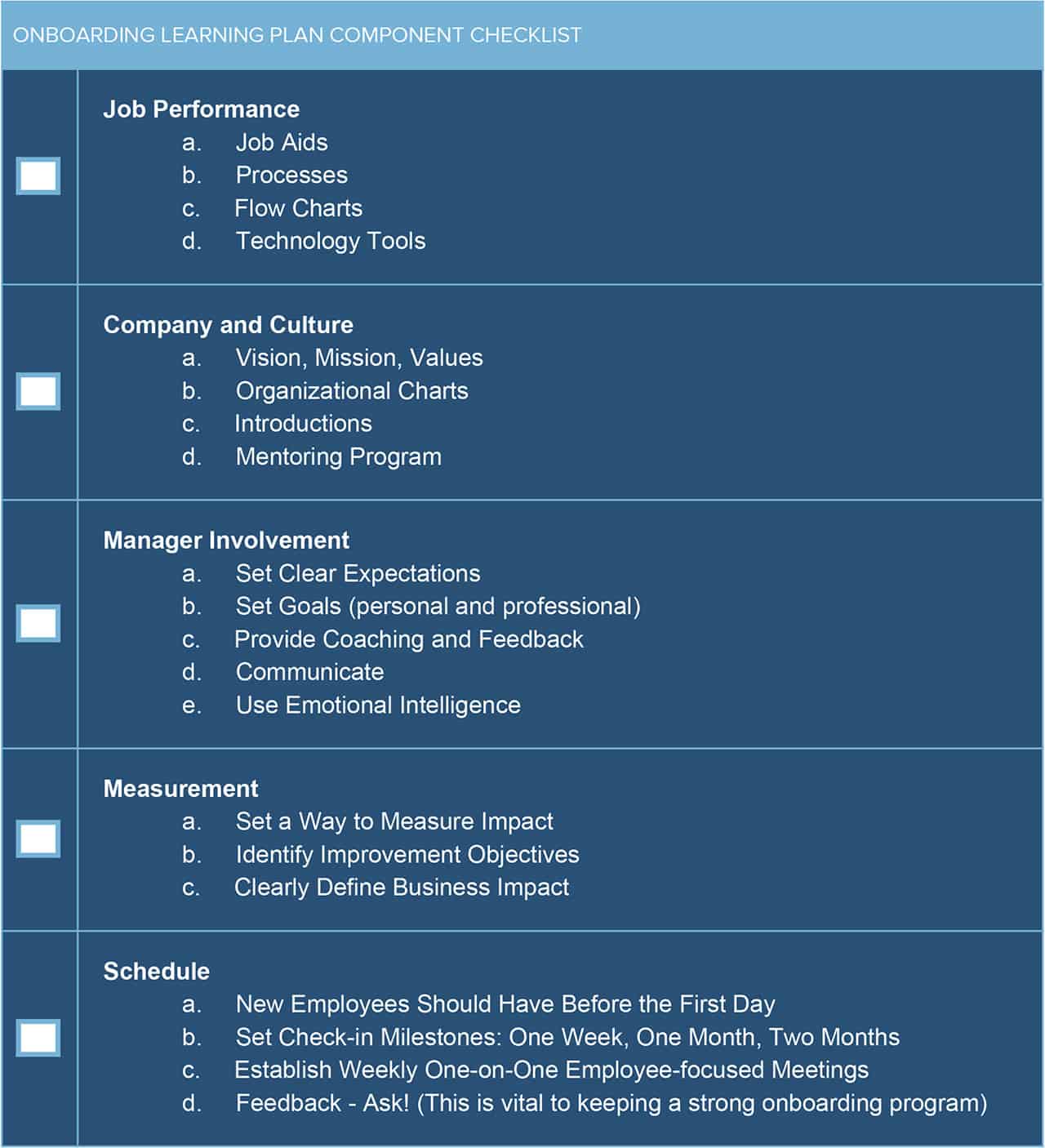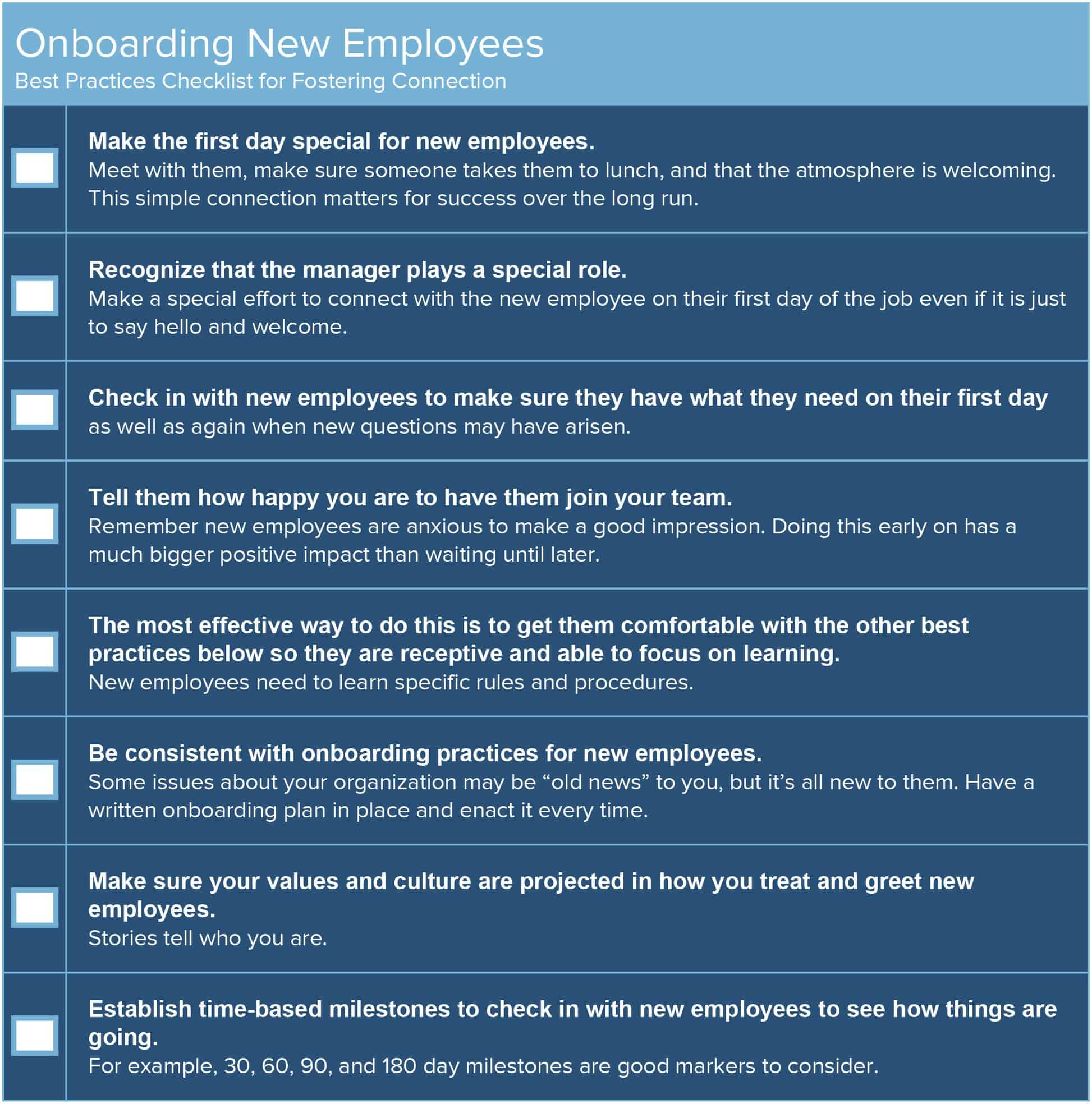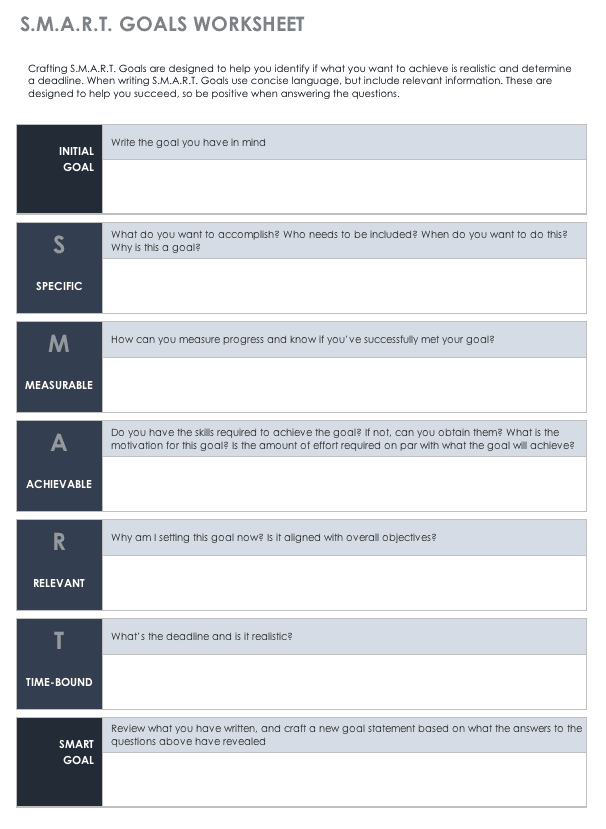What Is Onboarding?
Onboarding is a process that acclimates new employees to an organization and provides them with the knowledge, tools, and resources to become successful, productive, and engaged team members. The practice begins before the first day of work, and (as a generally accepted best practice) continues through the first 90 days of employment. Depending on the company/industry or position, it may continue through the first year.
The goal of onboarding is simple: to keep talent within your company. With the rise in voluntary termination occurring, a solid onboarding process is essential. The US Bureau of Labor Statistics reports, “Quits have increased since their low in September 2009 and are near their pre-recession levels. In December 2016, there were 3.0 million quits.”
Research from MIT Sloan Management cites onboarding (no matter how much time it takes) as the most critical period in an employee’s relationship with an organization with a long-lasting influence on engagement, performance, and retention. We asked human capital researchers, CEOs of HR companies, a business communications and professional development author, and a training expert and an HR software researcher to provide a deeper dive into onboarding so managers can build exceptional processes that keep employees loyal and engaged.
Benefits of a Formal Onboarding Process
Every expert we asked about the benefits of onboarding stresses the need for a formal, written onboarding plan. “Having a formal onboarding plan helps the new employee understand what is expected,” Hayashi says. “Reviewing the key accountabilities for the role and those of their peers helps to align expectations and avoid unnecessary conflict.”
In her ongoing research into onboarding best practices, Filipkowski finds that the investment in manpower, time, and money does pay off and that organizations that invest in onboarding:
- Emphasize people and performance over paperwork
- Create a partnership among HR, the manager, and the employee
- Establish onboarding as a continuous process
- Have the ability to measure outcomes
The net result? According to a 2016 study authored by Filipowski for HCI, invested onboarders are twice as likely to reduce new hire time to proficiency:
Source: 2016 Onboarding Outcomes: Fulfill New Hire Expectations by the HCI Institute
Kogan, who has built his firm Illumeo to focus on the fastest-possible individual and company success says, “People want to feel like they’re doing great at their job, that they’re killing it! This is ultimately what good onboarding is all about and what keeps people at your organization. Everyone wants to be good at their job and feel great about what they’re doing every day.”
Risks of No-or-Limited Onboarding Process
There’s a heavy downside to not investing in a formal, repeatable process. As Hayashi advises, “When organizations do not onboard properly, the result is an employee who does not understand the focus of the business, where we are going together, and how we intend to get there - and why the role you are in matters.”
In Filipkowski’s previously noted HCI research, the 400 participating organizations report underutilized onboarding practices. The participants acknowledged the risks of not following best practices: 74 percent reported that Onboarding practices have been underutilized at my organization, and 50 percent said Onboarding delivers on the promises made during our recruitment process.
The data could be interpreted to mean that while organizations understand the importance of onboarding in retaining talent, there is still a ways to go to meet the needs of new employees. 38 percent of companies said that they would be investing in an online onboarding platform and 26 percent said that they would increase their onboarding investments.
In the same research study, Filipkowski found the following:
- It’s common for most organizations to stop onboarding activities after the first week an employee is in the new role.
- This amount of time is not nearly enough time to orient, prepare, and develop a new hire to be successful in their new position.
- Most respondents believe that ‘re-boarding’ an internal hire is just as important as onboarding an external hire, but only 27 percent report that they effectively ‘re-board’ employees after they take on a new role.
It’s clear the onboarding isn’t simply a human resources function - it’s become a business imperative. How did we get here?
The Evolution of Onboarding
New employee orientation evolved into more strategically-oriented onboarding with the ground-breaking research of J. Van Maanen and E.H. Schein in 1979 into organizational socialization, or the process by which people learn the elements of their professional tasks within companies and organizations and are assimilated into company culture. Universities and major corporations like Hewlett-Packard adopted onboarding in the 1980s. As the value of bringing new hires into the organization with clear objectives was recognized, forward-thinking companies took notice and revamped their talent management process. As hiring and economic growth slowed in the 1990s, onboarding took a back seat, but saw a resurgence in the pre-recession 2000s. Major companies like Amazon, Microsoft, Google, and Facebook, technology startups, and other companies who are interested in retaining difficult-to-find talent take advantage of onboarding.
The U.S. News article Americans Quitting Their Jobs En Masse as Confidence Builds explains the reasons why onboarding is assuming greater importance today. With a stronger economy (now that we’re beyond the recession) and more job openings, workers are taking the opportunity to leave positions they dislike. For example, 80 percent of people on LinkedIn don’t enjoy or hate their jobs, and according to CareerBuilder, 76 percent of workers are actively looking for a new job.
Before designing or refining your employee onboarding process, let’s take a look at some important aspects of onboarding design.
The Nuances and Elements of Onboarding
- The Human Element: It’s not just about work tasks alone. Onboarding is also known as organizational socialization because not only does the process help employees understand their place in a company and their job duties, but there’s an element of enculturation that needs to be addressed for newcomers to feel comfortable and assimilate well into company culture. “I think making people feel welcome and part of the culture is at the heart of onboarding,” says Paugh. “At the company I now run, and at those I’ve run before, building an authentic sense of community and belonging is essential for success.”
- Orientation vs. Onboarding: Orientation is an event (usually a single event), while onboarding is an ongoing process. The predecessor to onboarding was orientation. Essentially, orientation offers first day nuts and bolts information about the employee’s role, office layout, and how to use the equipment. “Orientation is this very basic list of things like where’s the bathroom. I am not demeaning it, we have to do this,” says Kogan. “We have to get employees signed up. However, this has nothing to do with professional success, which is where I’m coming from and what employers and employees care about.”
- Training vs. Onboarding: Training covers the operational process of how employees will get their job done. Training can happen in one-on-one or class training sessions, in self-directed training through an HR software platform, and videos. It’s essential, but it may not cover how you and the new team member live and breathe your mission and brand.
- Onboarding at Every Scale: Your company size doesn’t matter if you want people to do well - you need to help them get off to the best possible start. While every manager wants new employees to hit the ground running, it pays to invest. Smaller companies may have specific cultures, and may need to be even more careful than larger ones to make assimilation into culture seamless. Paugh says, “Once your company starts to grow, it may not be possible to meet every single person for coffee, but if you’re building your company correctly, every manager is an advocate for the company and its mission. They should know the onboarding blueprint and take it to the people who work under them.”
- Executive Onboarding: Executives are usually seasoned vets, and yet they still need to be assimilated to some degree. “Executive onboarding includes a focus on how we lead, and how the leadership team works together,” says Hayashi. “If not covered in the interview process, it also includes the strategic vision for where the company is going in the next three years and how the executive’s role is expected to contribute. Meeting all the leaders in an informal setting is also helpful.”
As you customize your own onboarding process, it’s important to keep these items in mind as well as best practices.
Onboarding Best Practices: An Expert RoundUp
The rule of thumb is that onboarding should continue for at least ninety days. This is for many reasons, including the standard three-month grace period for new hires. It’s also the theme of onboarding bibles like Michael Watkins’ The First 90 Days, and the standard advised by the Society for Human Resource Management Foundation embodied in Onboarding New Employees: Maximizing Success by Talya N. Bauer. Our experts agree that it’s a best practice.
30 Days, 90 Days: Or Is Time Not the Main Factor?
Hayashi is in alignment with the one- to three-month approach to onboarding. “Every company needs an onboarding process that is customized to their culture,” she says. “There are three best practices for effective onboarding.”
1. Accountability: Have the key accountabilities for the role clearly defined and ensure the new employee understands them and is capable of delivering.
2. Communication: Provide a communication playbook that enables the team members to get to know each other easily, and encourage them to meet and discuss each person’s accountabilities and how they can work best together.
3. Culture: Describe the DNA of the culture, the team norms, and how people who are most successful here approach the first 30 to 90 days. Customize this practice to effectively describe the role and the organization.
5 Step Approach to Effective Onboarding
Kogan of Illumeo takes a slightly different approach. “I don’t think it’s about the 30/90 days approach,” he says. “We’re about helping people be successful and add value the right way. If you want to move the needle on a new hire’s business impact, the focus needs to be on job-specific-skills onboarding.”
“Forgotten between the three month ramp expectation and the idea that someone’s been onboarded once they get onto payroll is the fact that you just hired a really smart person who already knows how to do a lot of stuff, but will still struggle for three to six months learning how we do it here. Most people are hired with skills. In fact, you hired them because they have skills, but those skills don’t work for your company yet. You need to augment them, provide context, show how things are done. And invariably it happens, over the course of six months, with untold wasted time by the new employee, and untold wasted time from their manager training yet another new employee,” Kogan adds.
Source: Illumeo
Onboarding Expertise Management Cycle Checklist
Here’s the checklist that aligns with Kogan’s best practice model for onboarding:
One of the most important aspects of this type of onboarding process is repetition. “Employees and managers should continually be assessing, understanding, planning, learning, and doing,” says Kogan. “If you make that happen for yourself, for your organization, or for the company as a whole, you will probably be creating more value than anyone else and driving your own career forward, as well as that of everyone following this program.”
Resources to Ensure Successful New Employee Experiences
In addition to the resources you’ll find here, take advantage of the many checklists, planning tools, and templates found in Employee Onboarding Processes: Plans, Best Practices, Flowcharts and The Complete Guide to Employee Onboarding from HR Experts.
Before the First Day Checklist
Getting ‘newbies’ off on the right foot begins before the first day on the job. “A new position doesn’t begin on the first day,” says Paugh. “You want to get all of the paperwork and bureaucratic stuff out of the way so day one can be more focused.”
Try a new hire checklist to ensure everything is ready for a new employee’s first day.
New Hire Learning Plan
Like Kogan, Stephens of BizLibrary believes that providing a deep learning experience and detailed training is essential for employee success. “At BizLibrary, each new employee is given information that helps them know how they fit into the company.” says Stephens. “This is done by creating a new hire learning plan. The learning plan consists of online learning, classroom learning, peer shadowing, and involvement from leadership. Here’s the one we use.”
Source: BizLibrary
The Emotional Connection Checklist
At CommunityCo, Paugh goes the extra mile to bring new employees into the fold. “On day one, we assign a co-worker to take the new team member to breakfast. That way, they form an ally to count on for support. During the second week, I actually take the time to make a coffee date and make sure things are on track. For remote employees, we use Zoom and have a ‘virtual coffee’ date. These encounters aren’t just great for the new employee. They have never failed to reveal a great idea to make the company better in some way.”
Source: Dr. Talya Bauer’s Best Practices Checklist on Google Rework
SMART Target Setting Worksheet for New Employees
Supporting new employees means helping them set goals and develop reasonable timeframes to accomplish them. Using the SMART method (Specific, Measurable, Achievable, Relevant, Time-Bound) developed by George T. Doran in 1981 is a great pathway to personal accomplishment.
Download the SMART Goals Worksheet Template
Excel | WORD | PDF | Smartsheet
Employee Directory
Knowing how to reach out to co-workers is an essential component of making a new employee’s job easier. If you’re using an onboarding software platform, this is likely going to be an incorporated tool.
Onboarding Software Tools
Software Researcher Westfall notes the value of technology tools to make onboarding easier for managers and new hires. “To ensure new hires stay and succeed, here are a few tips for onboarding best practices and how software can help."
- Start Early: Provide an onboarding portal that employees can use before their first day so they can learn about the company and get the necessary forms completed in advance.
- Structure Schedules: Using a shared calendar or an onboarding platform, managers can create lists and schedules for new hires to make them feel secure for the first few weeks in their new position.
- Communicate Culture: New hires may fail because work habits or personality don’t click with the company’s culture. To learn whether the applicant and organization are a good fit, many recruiting platforms include pre-employment assessments to winnow out workers who have great skills but may not stand the test of time.
Top 10 Employee Onboarding Software
(Based on Software Advice Number of Recommendations as of February 2017)
Kronos Workforce Ready Suite
An enterprise-class human capital management system solution incorporates recruiting, onboarding, performance management, compensation planning, time and attendance, scheduling, absence management, payroll, and more.
ClearCompany Talent Management Software
Designed for HR and recruiting teams in public and private industries, the platform connects recruiting, new employee onboarding, and performance management. Their Applicant Tracking System includes features for requisition templates and bulk emails, advanced corporate site integration, mobile career sites, social sharing tools, referral management, and one-click background checks.
APS
APS (Automatic Payroll Systems, Inc.) has been providing payroll and tax compliance services to companies for almost two decades. In 2004, they released APS, a cloud-based solution for human capital management. APS combines their services in a streamlined format that can be scaled to various sized companies.
iCMS Talent Platform
A scalable online applicant tracking and recruiting solution to streamline recruiting activities. iCIMS Onboard assists recruiters in automating onboarding process of new hires. The solution also allows recruiters to design tasks for new hires, assign task due dates, and set automated reminders to ensure successful onboarding for every new hire.
Ascentis
An end-to-end human capital management suite designed to find, hire, and onboard the best candidates. Built-in features include career portals, social sharing, candidate data analysis, onboarding, and more.
Sage People HCM
Enables mid-size companies to large enterprises to manage how they acquire, engage, and develop their people, from a local to multinational scale. This is a cloud-based solution with a high-level of customization that provides core HR, payroll, talent acquisition, talent management, onboarding, and HR planning.
RUN Powered by ADP
RUN Powered by ADP is a web-based payroll solution designed for small businesses. The built-in human resources management services provide access to HR experts via HR Helpdesk for best practice answers to HR-related queries.
Jobvite
Jobvite’s recruiting platform is designed to help emerging and enterprise companies hire talent. The Jobvite solution supports every stage of the recruiting funnel from sourcing to onboarding.
Threads Culture
A culture-based platform that assists in hiring and nurturing people within the organization based on ideals and principles that align with a company's core values. The result is a team of individuals that support each other and propel the company forward.
Improve Employee Onboarding with Smartsheet for Human Resources
Empower your people to go above and beyond with a flexible platform designed to match the needs of your team — and adapt as those needs change.
The Smartsheet platform makes it easy to plan, capture, manage, and report on work from anywhere, helping your team be more effective and get more done. Report on key metrics and get real-time visibility into work as it happens with roll-up reports, dashboards, and automated workflows built to keep your team connected and informed.
When teams have clarity into the work getting done, there’s no telling how much more they can accomplish in the same amount of time. Try Smartsheet for free, today.
